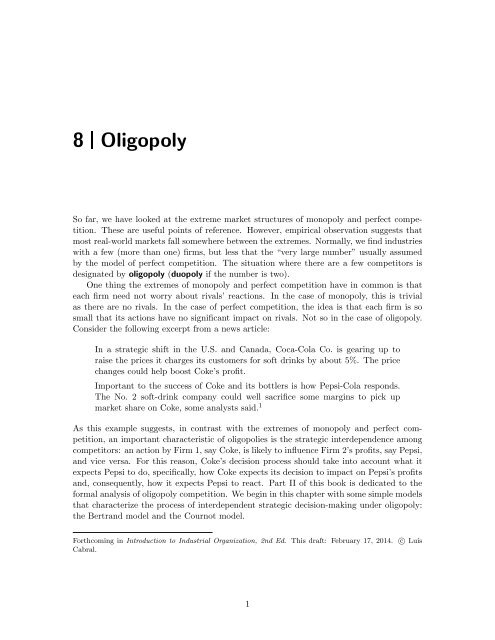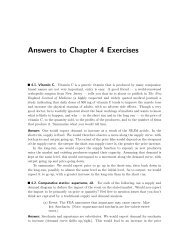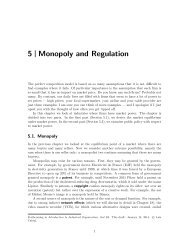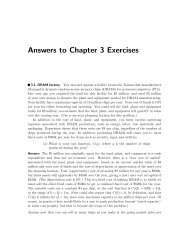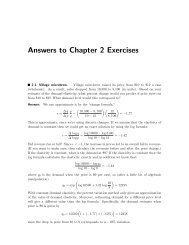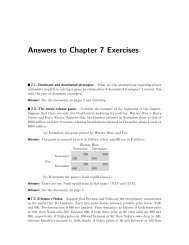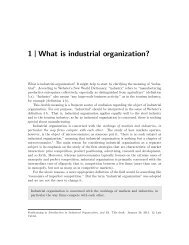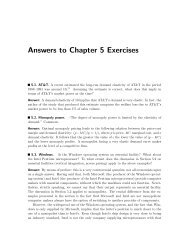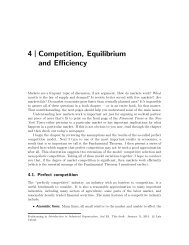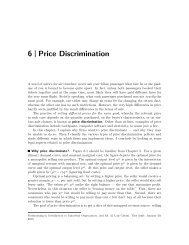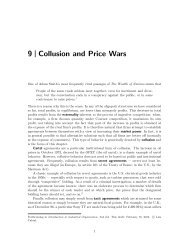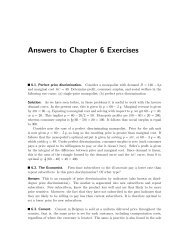8 Oligopoly - Luiscabral.net
8 Oligopoly - Luiscabral.net
8 Oligopoly - Luiscabral.net
Create successful ePaper yourself
Turn your PDF publications into a flip-book with our unique Google optimized e-Paper software.
8 <strong>Oligopoly</strong><br />
So far, we have looked at the extreme market structures of monopoly and perfect competition.<br />
These are useful points of reference. However, empirical observation suggests that<br />
most real-world markets fall somewhere between the extremes. Normally, we find industries<br />
with a few (more than one) firms, but less that the “very large number” usually assumed<br />
by the model of perfect competition. The situation where there are a few competitors is<br />
designated by oligopoly (duopoly if the number is two).<br />
One thing the extremes of monopoly and perfect competition have in common is that<br />
each firm need not worry about rivals’ reactions. In the case of monopoly, this is trivial<br />
as there are no rivals. In the case of perfect competition, the idea is that each firm is so<br />
small that its actions have no significant impact on rivals. Not so in the case of oligopoly.<br />
Consider the following excerpt from a news article:<br />
In a strategic shift in the U.S. and Canada, Coca-Cola Co. is gearing up to<br />
raise the prices it charges its customers for soft drinks by about 5%. The price<br />
changes could help boost Coke’s profit.<br />
Important to the success of Coke and its bottlers is how Pepsi-Cola responds.<br />
The No. 2 soft-drink company could well sacrifice some margins to pick up<br />
market share on Coke, some analysts said. 1<br />
As this example suggests, in contrast with the extremes of monopoly and perfect competition,<br />
an important characteristic of oligopolies is the strategic interdependence among<br />
competitors: an action by Firm 1, say Coke, is likely to influence Firm 2’s profits, say Pepsi,<br />
and vice versa. For this reason, Coke’s decision process should take into account what it<br />
expects Pepsi to do, specifically, how Coke expects its decision to impact on Pepsi’s profits<br />
and, consequently, how it expects Pepsi to react. Part II of this book is dedicated to the<br />
formal analysis of oligopoly competition. We begin in this chapter with some simple models<br />
that characterize the process of interdependent strategic decision-making under oligopoly:<br />
the Bertrand model and the Cournot model.<br />
Forthcoming in Introduction to Industrial Organization, 2nd Ed. This draft: February 17, 2014.<br />
Cabral.<br />
c○ Luís<br />
1
8.1. The Bertrand model<br />
Pricing is probably the most basic strategy that firms must decide on. The demand received<br />
by each firm depends on the price it sets. Moreover, when the number of firms is small,<br />
demand also depends on the prices set by rival firms. It is precisely this interdependence between<br />
rivals’ decisions that differentiates duopoly competition (and more generally oligopoly<br />
competition) from the extremes of monopoly and perfect competition. When Lenovo, for<br />
example, decides what prices to set for its PCs, the company has to make some conjecture<br />
regarding the prices set by rival Dell; and based on this conjecture determine the optimal<br />
price, taking into account how demand for the Lenovo PC depends on both the Lenovo<br />
price and the Dell price. a<br />
In order to analyze the interdependence of pricing decisions, we begin with the simplest<br />
model of duopoly competition: the Bertrand model. 2 The model consists of two firms in a<br />
market for a homogeneous product and the assumption that firms simultaneously set prices.<br />
We also assume that both firms have the same constant marginal cost, MC = c. b<br />
Since the duopolists’ products are perfect substitutes (the product is homogeneous), and<br />
since firms have no capacity constraint, it follows that whichever firm sets the lowest price<br />
gets all of the demand. Specifically, if p i , the price set by firm i, is lower than p j , the price<br />
set by firm j, then firm i’s demand is given by D(p i ) (the market demand), whereas firm<br />
j’s demand is zero. If both firms set the same price, p i = p j = p, then each firm receives<br />
one half of market demand, 1 2 D(p).<br />
The discrete Bertrand game. Let us first consider the case when sellers are restricted to<br />
a limited set of price levels. Specifically, suppose that market demand is given by q = 10−p,<br />
marginal cost constant at 2, and sellers can only set integer values of price: 3, 4 and<br />
5. Figure 8.1 describes the game in normal form (similarly to the games introduced in<br />
Chapter 7): Firm 1 chooses a row (5, 4 or 3), whereas Firm 2 chooses a column (5, 4 or<br />
3). For each possible combination, profits are determined according to the rules described<br />
in the preceding paragraph. For example, if both firms set p = 5, then total demand is<br />
q = 10 − 5 = 5; and each firm’s profit is given by π = 1 2<br />
5 (5 − 2) = 7.5. If Firm 1 sets<br />
p 1 = 4 whereas Firm 2 sets p 2 = 5, then Firm 1 captures all of the market demand, which<br />
is now given by q = 10 − 4 = 6. It follows that π 1 = 6 (4 − 2) = 12, whereas π 2 = 0. The<br />
remaining cells of the game matrix are obtained in a similar manner. (Check this.)<br />
What is the game’s equilibrium? First notice that there is no dominant strategy. I can<br />
however derive each firm’s best response and from this derive the game’s Nash equilibrium.<br />
Firm 1’s best response mapping is as follows: if Firm 2 sets p 2 = 5, then Firm 1’s optimal<br />
price is p 1 = 4; if Firm 2 sets p 2 = 4, then Firm 1’s optimal price is p 1 = 3; and finally, if<br />
Firm 2 sets p 2 = 3 then Firm 1’s optimal price is p 1 = 3. In words, Firm 1’s best response<br />
is to undercut Firm 2 — unless Firm 2 is already setting the lowest price. As a result, the<br />
Nash equilibrium corresponds to both firms setting the lowest price: ̂p 1 = ̂p 2 = 3.<br />
Notice that, while the game is not, strictly speaking, a a prisoner’s dilemma, it does<br />
share some of the features of the prisoner’s dilemma game (cf Chapter 7). Specifically, (a)<br />
a. Moreover, in a dynamic setting, Lenovo must also take into account that current price choices will<br />
likely influence the rival’s future price choices. This we will see in Chapter 9.<br />
b. The Bertrand model is more general than the simplified version presented here, but the main ideas<br />
are the same.
Figure 8.1<br />
Bertrand game with limited number of price choices<br />
Firm 1<br />
5<br />
4<br />
3<br />
Firm 2<br />
5 4 3<br />
7.5 12 7<br />
7.5 0 0<br />
0 6 7<br />
12 6 0<br />
0 0 3.5<br />
7 7 3.5<br />
both firms are better off by setting a high price; (b) however, given that both firms set a<br />
high price, both firms have an incentive to undercut the rival.<br />
The above game is based on a number of simplifying assumptions. In particular, I am<br />
restricting firms to set prices at integer values (3, 4 or 5). What if Firm 1 could undercut<br />
p 2 = 5 by setting p 1 = 4.99? In the next paragraphs, I consider the more general case when<br />
firms can set any value of p i , in fact any real value. As we will see, the main qualitative<br />
results and intuition remain valid. In fact, in some sense the result will be even more<br />
extreme.<br />
The continuous case. Suppose now that firms can set any value of p from 0 to +∞,<br />
including non-integer values. Now we are unable to describe the game as a matrix of<br />
strategies (there are infinitely many strategies). However, we can derive, as before, each<br />
firm’s best response mapping, from which we can then derive the Nash equilibrium. Recall<br />
that firm i’s best response p ∗ i (p j) is a mapping that gives, for each price by firm j, firm i’s<br />
optimal price. The only novelty with respect to the discrete case is that the values of p j<br />
and p i now vary continuously.<br />
Suppose that Firm 1 expects Firm 2 to price above monopoly price. Then Firm 1’s<br />
optimal strategy is to price at the monopoly level. In fact, by doing so Firm 1 gets all of the<br />
demand and receives monopoly profits (the maximum possible profits). If Firm 1 expects<br />
Firm 2 to price below monopoly price but above marginal cost, then Firm 1’s optimal<br />
strategy is to set a price just below Firm 2’s: c pricing above would lead to zero demand<br />
and zero profits; and pricing below gives firm i all of the market demand, but lower profits<br />
the lower the price is. Finally, if Firm 1 expects Firm 2 to price below marginal cost, then<br />
Firm 1 optimal choice is to price higher than Firm 2, say, at marginal cost level.<br />
Figure 8.2 depicts Firm 1’s best response, p ∗ 1 (p 2), in a graph with each firm’s strategy<br />
on each axis. Consistent with the above derivation, for values of p 2 less than MC , Firm 1<br />
chooses p 1 = MC = c. For values of p 2 greater than MC but lower than p M , Firm 1 chooses<br />
p 1 just below p 2 . Finally, for values of p 2 greater than monopoly price, p M , Firm 1 chooses<br />
c. What does “just below” mean? If p 1 could be any real number, than “just below” would not be well<br />
defined: there exists no real number “just below” another real number. In practice, prices have to<br />
be set on a finite grid (in cents of the dollar, for example), in which case “just below” would mean<br />
one cent less. This points to an important assumption of the Bertrand model: Firm 1 will steal all<br />
of Firm 2’s demand even if its price is only one cent lower than the rival’s.
Figure 8.2<br />
Bertrand model: best responses and equilibrium.<br />
p ∗ 2(p 1 )<br />
p ∗ 1(p 2 )<br />
̂p 1 = c<br />
N<br />
•<br />
p 1<br />
... ... ... . . .... ... ... ... .. .... ... .... ... ... ... ... . ............<br />
p 2<br />
̂p 2 = c<br />
p 1 = p M .<br />
Since Firm 2 has the same marginal cost as Firm 1, its best response is identical to Firm<br />
1’s, that is, symmetric with respect to the 45 ◦ line. In Figure 8.2, Firm 2’s best response is<br />
given by p ∗ 2 (p 1).<br />
As we saw in Chapter 7, a Nash equilibrium is a pair of strategies — a pair of prices,<br />
in the present case — such that no firm can increase profits by unilaterally changing price.<br />
In terms of Figure 8.2, this is given by the intersection of the best responses, that is, point<br />
N. In fact this is the point at which p 1 = p ∗ 1 (p 2) (because the point is on Firm 1’s best<br />
response) and p 2 = p ∗ 2 (p 1) (because the point is on Firm 2’s best response). As can be seen<br />
from Figure 8.2, point N corresponds to both firms setting a price equal to marginal cost,<br />
̂p 1 = ̂p 2 = MC = c.<br />
Another way of deriving the same conclusion is to think about a possible equilibrium<br />
price p ′ greater than marginal cost. If both firms were to set that price, each would earn<br />
1<br />
2 D(p′ )(p ′ − MC ). However, but setting a slightly smaller price, one of the firms would be<br />
able to almost double its profits to D(p ′ − ɛ)(p ′ − ɛ − MC ), where ɛ is a small number. This<br />
argument holds for any possible candidate equilibrium price p ′ greater than marginal cost.<br />
We thus conclude that the only possible equilibrium price is p = c. In summary,<br />
Under price competition with homogeneous product and constant, symmetric marginal<br />
cost (Bertrand competition), firms price at the level of marginal cost.<br />
Notice that this result is valid even with only two competitors (as we have considered<br />
above). This is a fairly drastic result: as the number of competitors changes from one<br />
to two, equilibrium price changes from monopoly price to perfect competition price. Two<br />
competitors are sufficient to guarantee perfect competition.<br />
From a consumer welfare point of view, Bertrand competition is a tremendous boon.<br />
From the seller’s point of view, however, it is a rather unattractive situation: the Bertrand<br />
trap, as some call it. Consider for example the case of encyclopedias. 4 Encyclopedia Bri-
Box 8.1. Digital yellow pages: from monopoly to duopoly to oligopoly. 3<br />
In 1987, Nynex began offering in digital form the entire telephone directory for the<br />
area the company then served (New York and New England). With a list price of<br />
$10,000, the CD product was primarily targeted at retailers, government departments<br />
and financial service operators.<br />
Soon after, Jim Bryant, the Nynex executive in charge of developing the new Nynex<br />
product, decided to leave the company and found Pro CD, a company devoted to<br />
publishing white and yellow page directories in electronic form.<br />
Fearing competition, Nynex declined to offer the required data for Pro CD to compile<br />
his listing. Undeterred by this obstacle, Bryant sent physical copies of the directories<br />
to Asia, where he outsourced the task of typing them from scratch (and retyping, to<br />
check for errors). All in all, Pro CD created a mega-directory with more than 70 million<br />
entries.<br />
Facing competition in the market for electronic directories, Nynex was forced to lower<br />
its price. By the early 1990s, sale prices were in the hundreds of dollars, down from the<br />
original $10,000 price tag. Meanwhile, additional entrants joined Pro CD in challenging<br />
Nynex’s initial monopoly. By 2000, a complete directory could be bought for a mere<br />
$20. e<br />
tannica has been, for more than two centuries, a standard reference work. Until the 1990s,<br />
the thirty-two-volume hardback set sold for $1,600. Then Microsoft entered the market<br />
with Encarta, which it sold on CD for less than $100. Britannica responded by issuing its<br />
own CD version as well. By 2000, both Britannica and Encarta were selling for $89.99.<br />
While this is still far from the Bertrand equilibrium (price equal to the cost of the CDs)<br />
it is certainly closer to Bertrand than the initial, monopoly-like price of $1,600. Box 8.1<br />
describes another example of how even one competitor can drive prices down tremendously.<br />
Avoiding the Bertrand trap. There are many real-world markets where the number of<br />
firms is small — two or a few more —, firms compete on price, and still firm profits are<br />
positive — sometimes very large. (Can you think of some?) This seems to contradict<br />
the Bertrand model’s prediction. How can we explain this apparent contradiction between<br />
theory and empirical observation? Put differently: if you consult with a firm competing<br />
in a price-setting duopoly, how do you help your client avoid the Bertrand trap? In what<br />
follows, I consider four different solutions, two which I will develop in later chapters, two of<br />
which I will cover in the remainder of this section.<br />
1. Product differentiation. The Bertrand model assumes that both firms sell the same<br />
product. If instead firms sell differentiated products, then duopoly price competition<br />
does not necessarily drive prices down to marginal cost as predicted by the Bertrand<br />
model. In fact, undercutting the rival does not guarantee that a firm will get total<br />
e. Eventually, Pro CD became the first company to compile all of the published telephone directories<br />
in the United States and Canada. In 1996, it merged with Acxiom, a company that integrates data,<br />
services and technology to create and deliver customer and information management solutions.
market demand. Take, for example, the cola market. In the U.S. and in many other<br />
countries, Pepsi and Coke are the two main competitors. Brand allegiance tends to<br />
be very high and cross-price elasticity tends to be relatively close to zero. By lowering<br />
its price, Coke may increase its sales a bit, but it will certainly not capture all of<br />
the market demand (as assumed under Bertrand competition). The issues of product<br />
differentiation and brand allegiance are examined in Chapters 15 and 16.<br />
2. Dynamic competition. The Bertrand model assumes that firms compete in one period<br />
only; that is, price is chosen once and for all. One of the likely consequences<br />
of undercutting a rival’s price is that the latter will retaliate by lowering its price<br />
too, possibly initiating a price war. For example, if the BP gas station lowers its<br />
price today, it may attract additional customers who were previously filling up at the<br />
Exxon gas station across the street; but before long the Exxon gas station is bound to<br />
respond. In that case, undercutting does not guarantee a firm total market demand,<br />
except perhaps in the very short run. The possibility of retaliation is not considered<br />
in the Bertrand model because of its static nature. In the next chapter, I will consider<br />
dynamic games and show that, even when firms set prices and the product is<br />
homogeneous, there exist equilibria where price is strictly greater than marginal cost.<br />
3. Asymmetric costs. One important assumption in the simple version of the Bertrand<br />
model I considered above is that both firms have the same marginal cost. As we will<br />
see below, if one of the firms has a lower marginal cost (a “cost leader”) then it is no<br />
longer true that both firms earn zero profits.<br />
4. Capacity constraints. By undercutting the rival, a Bertrand duopolist receives all<br />
of the market demand. But what good is this if the firm does not have sufficient<br />
capacity to satisfy all of this demand? In other words, one important assumption<br />
of the Bertrand model is that firms have no capacity constraints. Below I show<br />
that, if there are capacity constraints, then the nature of competition may change<br />
considerably.<br />
Price competition with different costs. Consider the Portuguese wholesale gasoline<br />
market. There are essentially two sellers (that is, two supply sources): Galp, which owns all<br />
of the country’s refineries; and imports. Typically, the import price is greater than Galp’s<br />
cost. As a result, Galp supplies all retailers at the import price and effectively maintains a<br />
100% market share in wholesale gasoline sales (that is, imports represent a very small share<br />
of total sales). In sum, although the product is relatively homogeneous and competition<br />
is based on price, Galp sells at a positive margin, the reason being that Galp has a lower<br />
marginal cost than its competitors.<br />
The simple version of the Bertrand model I considered before assumed that both firms<br />
had the same marginal cost. Suppose now that one of the firms, say Firm 1, has a lower<br />
marginal cost than its rival. The situation is depicted in Figure 8.3. The best response<br />
curves are derived as before: firm i undercuts the rival all the way down to its marginal<br />
cost — that is, all the way down to firm i’s marginal cost. In this case, since Firm 1 has a<br />
lower marginal cost, its best response mapping extents to lower values than Firm 2’s. As a<br />
result, the point where the two best responses cross — the Nash equilibrium of the game
Figure 8.3<br />
Bertrand equilibrium with different marginal costs<br />
p ∗ 2(p 1 )<br />
45 ◦ p ∗ 1(p 2 )<br />
p M p 2 = MC 2 p M<br />
p 1 ... .... .... .... .... .... .... .... .... .... .... .... .... .... .... .... ... .... .... .... .... .... .... .... .... .... .... .... .... .... .... .... .... . ....................<br />
p 2<br />
̂p 1 = MC 2 − ɛ<br />
•<br />
... ..... .... .... .... .... .... .. . .... ... .... .... .... .... ..... .... ... .... .... .... .... .... .<br />
............<br />
MC 1<br />
— is given by p 2 = MC 2 and p 1 = MC 2 − ɛ; that is, Firm 1 just undercuts Firm 2 and gets<br />
all of the market demand.<br />
In other words, one way out of the Bertrand trap is to be a cost leader. For years, Dell<br />
managed to make considerable profits in a highly commoditized industry (desktop computers).<br />
Part of Dell’s secret was to create a very efficient supplier system which effectively<br />
gave it a lower marginal cost. Unfortunately, others can play that game too: frequently,<br />
competitive advantages based on cost leadership are short lived.<br />
Price competition with capacity constraints. Suppose now that each firm is constrained<br />
by its capacity, k i . That is, firm i cannot sell more than k i : if its demand turns out to be<br />
greater than k i , then its sales are k i only. Otherwise, we maintain the same assumptions as<br />
before: firms simultaneously set prices, marginal cost is constant (zero, for simplicity), and<br />
the product is homogeneous.<br />
Under Bertrand competition, if Firm 2 were to set a price greater than Firm 1’s, its<br />
demand would be zero. The same is not necessarily true if Firm 1 is capacity constrained.<br />
Suppose that p 2 > p 1 and that D(p 1 ) > k 1 , that is, Firm 1 is capacity constrained. Firm<br />
1’s sales will be given by k 1 : it will sell as much as it can. Firm 2’s demand, in turn, will<br />
be given by D(p 2 ) − k 1 (or zero, if this expression is negative). D(p 2 ) would be Firm 2’s<br />
demand if it had no competition. Having a rival price below, some of that demand will<br />
be stolen, specifically, k 1 . However, if k 1 is small enough, a positive residual demand will<br />
remain. f<br />
The situation of price competition with capacity constraints is illustrated in Figure 8.4.<br />
D(p) is the demand curve. Two vertical lines represent each firm’s capacity. In this example,<br />
Firm 2 is the one with greater capacity: k 2 > k 1 . The third vertical line, k 1 + k 2 , represents<br />
total industry capacity.<br />
f. For aficionados only: the above expression for firm i’s residual demand, D(p i) − k j, is only valid<br />
under the assumption that the customers served by firm j are the ones with the greatest willingness<br />
to pay. 5
Figure 8.4<br />
Capacity constraints<br />
p<br />
... .... .... ... ... ... .... ... ... .... ....<br />
P (k 1 + k 2 )<br />
.. .. .. . . ... ... ... ... .. .. .. . . ... ... ... ... .. .. .. . . ... ... ... ... .. .. .. . .<br />
r 2<br />
d 2<br />
D<br />
q 1 , q 2<br />
k 1 k 2 k 1 + k 2<br />
Let P (Q) be the inverse demand curve, that is, the inverse of D(p). g Moreover, let<br />
P (k 1 + k 2 ) be the price level such that, if both firms were to set p = P (k 1 + k 2 ), total<br />
demand would be exactly equal to total capacity. This price level is simply derived from<br />
the intersection of the demand curve with the total capacity curve. We will now argue that<br />
the equilibrium of the price-setting game consists of both firms setting p i = P (k 1 + k 2 ). In<br />
other words, firms set prices such that total demand equals industry capacity.<br />
Let us consider Firm 2’s optimization problem assuming that Firm 1 sets p 1 = P (k 1 +k 2 ).<br />
Can Firm 2 do better than setting p 2 = p 1 = P (k 1 + k 2 )? One alternative strategy is to<br />
set p 2 < P (k 1 + k 2 ). By undercutting its rival, Firm 2 receives all of the market demand.<br />
However, since Firm 2 is already capacity constrained when it sets p 2 = P (k 1 + k 2 ), setting<br />
a lower price does not help: on the contrary, Firm 2 receives lower profits by setting a lower<br />
price (same output sold at a lower price).<br />
What about setting a price higher than P (k 1 + k 2 )? The idea is that, since Firm 1 is<br />
capacity constrained when p 1 = P (k 1 + k 2 ), Firm 2 will receive positive demand even if it<br />
prices above Firm 1. Figure 8.4 depicts Firm 2’s residual demand, d 2 , under the assumption<br />
that p 2 > p 1 and p 1 = P (k 1 + k 2 ): Firm 2 gets D(p 2 ) minus Firm 1’s output, k 1 , so d 2 is<br />
parallel to D, the difference being k 1 . The figure also depicts Firm 2’s marginal revenue<br />
curve, r 2 . As can be seen, marginal revenue is greater than marginal cost (zero) for every<br />
value of output less than Firm 2’s capacity. This implies that setting a higher price than<br />
P (k 1 + k 2 ), which is the same as selling a lower output than q 2 = k 2 , would imply a lower<br />
profit: the revenue loss (the positive marginal revenue) is greater than the cost saving (the<br />
value of marginal cost, which is zero).<br />
A similar argument would hold for Firm 1 as well: given that p 2 = P (k 1 + k 2 ), Firm 1’s<br />
optimal strategy is to set p 1 = P (k 1 + k 2 ). We thus conclude that p 1 = p 2 = P (k 1 + k 2 )<br />
is indeed an equilibrium. Notice that, if capacity levels were very high, then the above<br />
argument would not hold; that is, it might be optimal for a firm to undercut its rival’s<br />
g. D(p), the direct demand curve (or simply demand curve), corresponds to taking price as the independent<br />
variable, that is, quantity as a function of price; P (Q), the inverse demand curve, corresponds<br />
to taking quantity as the independent variable, that is, price as a function of quantity.
Box 8.2. WorldCom and the U.S. telecoms price wars. 7<br />
After merging with MCI in 1998, WorldCom became one of the leading players in the<br />
global telecom industry. Central to WorldCom’s strategy was tapping into the Inter<strong>net</strong>’s<br />
rapid growth by expanding fiber optic capacity. The company’s mantra — shared<br />
by many industry analysts — was that Inter<strong>net</strong> traffic was doubling every 100 days.<br />
Unfortunately, WorlCom was not the only game in town: “In 1998 anyone who announced<br />
plans to layer fiber could get $1 billion from Wall Street, no questions asked.”<br />
And many did. Moreover, the estimates of the growth in Inter<strong>net</strong> traffic turned out<br />
to be wildly exaggerated: what happened in the early 1990s was no longer true by the<br />
late 1990s.<br />
As a result, the telecom industry imploded. Excess capacity fueled vicious price wars.<br />
Many startups filed for bankruptcy, dumping their capacity on the market at bargainbasement<br />
prices. Meanwhile, the long-reliable long-distance voice market lost share to<br />
wireless. WorldCom wasn’t immune to these events, and its stock price fell by 70%<br />
during 2000.<br />
One analyst summarized the events as follow: “WorldCom’s main transgression was to<br />
pour gasoline on the Inter<strong>net</strong> fire. The technological revolution was pretty powerful as<br />
it was, but WorldCom made it much worse than it would have been.”<br />
price. However, if capacities are relatively small, then the result obtains that equilibrium<br />
prices are such that total demand equals total capacity. 6 In summary:<br />
If total industry capacity is low in relation to market demand, then equilibrium prices<br />
are greater than marginal cost.<br />
Conversely, if industry capacity is very high, then an equilibrium with positive margins<br />
may turn into the Bertrand trap we saw earlier. Box 8.2 summarizes the case of WorlCom<br />
and the long-distance telecommunications industry: a glut of fiber optic capacity pushed<br />
prices down to marginal cost, leading many firms to bankruptcy and sowing the seeds of<br />
WorldCom’s eventual demise.<br />
8.2. The Cournot model<br />
In the previous section, we concluded that, if firms’ sales are limited by the capacity they<br />
created beforehand, then in equilibrium firms set prices such that total demand just clears<br />
total capacity. The same applies for the choice of output level, to the extent that firms must<br />
first produce a certain amount and then set prices to sell the output previously produced.<br />
This analysis can be taken one step back: what output levels should firms choose in the first<br />
place? Suppose that output decisions are made simultaneously before prices are chosen.<br />
Based on the above analysis, firms know that, for each pair of output choices (q 1 , q 2 ),<br />
equilibrium prices will be p 1 = p 2 = P (q 1 + q 2 ). This implies that firm i’s profit is given by
Figure 8.5<br />
Firm 1’s optimum<br />
p<br />
P (q 2 )<br />
D<br />
c<br />
P (q ′ 1 + q 2 )<br />
r 1 (q 2 )<br />
.<br />
.<br />
.<br />
.<br />
.<br />
.<br />
.<br />
.................................................................................................................................................... ....................................................................................................................................................<br />
.<br />
.<br />
.<br />
.<br />
.<br />
.<br />
.<br />
q 2<br />
d 1 (q 2 )<br />
MC<br />
q 1 , q 2<br />
q ∗ 1(q C ) q ∗ 1(q 2 ) q ∗ 1(0) q ′ 1 q ′ 1 + q 2<br />
(<br />
π i = q i P (q1 + q 2 ) − c ) , assuming, as before, constant marginal cost.<br />
The game where firms simultaneously choose output levels is known as the Cournot<br />
model. 8 Specifically, suppose there are two firms in a market for a homogeneous product.<br />
Firms choose simultaneously the quantity they want to produce. The market price is then<br />
set at the level such that demand equals the total quantity produced by both firms.<br />
As in Section 8.1, our goal is to derive the equilibrium of the model, that is, the equilibrium<br />
of the game played between the two firms. Also as in Section 8.1, we do so in two<br />
steps. First, we derive each firm’s optimal choice given its conjecture of what the rival does,<br />
that is, the firm’s best response. Second, we put the best response mappings together and<br />
find a mutually consistent combination of actions and conjectures.<br />
Suppose that Firm 1 believes Firm 2 is producing quantity q 2 . What is Firm 1’s optimal<br />
quantity? The answer is provided by Figure 8.5. If Firm 1 decides not to produce anything,<br />
then price is given by P (0 + q 2 ) = P (q 2 ). If Firm 1 instead produces q 1 ′ , then price is given<br />
by P (q 1 ′ + q 2). More generally, for each quantity that Firm 1 might decide to set, price is<br />
given by the curve d 1 (q 2 ), which is referred to as Firm 1’s residual demand: it gives all<br />
possible combinations of Firm 1’s quantity and price for a given a value of q 2 .<br />
Having derived Firm 1’s residual demand, the task of finding Firm 1’s optimum is now<br />
similar to finding the optimum under monopoly, which we have already done in Chapter<br />
5. Basically, we must determine the point where marginal revenue equals marginal cost.<br />
Marginal cost is constant by assumption and equal to c. Marginal revenue is a curve with<br />
twice the slope of d 1 (q 2 ) and with the same vertical intercept. h The point at which the two<br />
curves intersect corresponds to quantity q1 ∗(q 2), Firm 1’s best response to Firm 2’s strategy.<br />
Notice that Firm 1’s optimum, q1 ∗(q 2), depends on its belief of what Firm 2 chooses.<br />
In order to find an equilibrium, we are interested in deriving Firm 1’s optimum for other<br />
possible values of q 2 . Figure 8.5 considers two other possible values of q 2 . If q 2 = 0,<br />
then Firm 1’s residual demand is effectively the market demand: d 1 (0) ≡ D. The optimal<br />
h. This results from our assumption that demand is linear. In general, the marginal revenue curve has<br />
the same intercept as the demand curve and a higher slope (in absolute value), not necessarily twice<br />
the slope of the demand curve.
solution, not surprisingly, is for Firm 1 to chose the monopoly quantity: q1 ∗(0) = qM , where<br />
q M is the monopoly quantity. If Firm 2 were to chose the quantity corresponding to perfect<br />
competition, that is q 2 = q C , where q C is such that P (q C ) = c, then Firm 1’s optimum<br />
would be to produce zero: q1 ∗(qC ) = 0. In fact, this is the point at which marginal cost<br />
intercepts the marginal revenue corresponding to d 1 (q C ).<br />
It can be shown that, given a linear demand and constant marginal cost, the function<br />
q1 ∗(q 2) — Firm 1’s best response mapping — is also linear. Since we have two points, we<br />
can draw the entire function q1 ∗(q 2). This is done in Figure 8.6. Notice that the axes are<br />
now different from the previous figures. On the horizontal axis, we continue measuring<br />
quantities, specifically, Firm 2’s quantity, q 2 . On the vertical axis, we now measure Firm<br />
1’s quantity, q 1 , not price.<br />
Algebraic derivation. Throughout this chapter, in parallel with the graphical derivation<br />
of equilibria, I also present the correponding algebraic derivation. Except for some results<br />
in the next section, algebra is not necessary for the derivation of the main results; but it<br />
may help, especially if you are familiar with basic algebra and calculus. Let me start with<br />
the algebraic derivation of Firm 1’s best response. Suppose that (inverse) demand is given<br />
by P (Q) = a − b Q, whereas cost is given by C(q) = c q, where q is the firm’s output and<br />
Q = q 1 + q 2 is total output.<br />
Firm 1’s profit is<br />
π 1 = P q 1 − C(q 1 ) = ( a − b (q 1 + q 2 ) ) q 1 − c q 1<br />
The first-order condition for the maximization of π 1 with respect to q 1 , ∂ π 1 /∂ q 1 = 0, is<br />
or simply<br />
−b q 1 + a − b (q 1 + q 2 ) − c = 0<br />
q 1 = a − c − q 2<br />
2 b 2<br />
Since this gives the optimum q 1 for each value of q 2 , we have just derived the Firm 1’s<br />
best response, q1(q ∗ 2 ):<br />
q ∗ 1(q 2 ) = a − c<br />
2 b<br />
− q 2<br />
2<br />
(1)<br />
We are now ready for the last step in our analysis, that of finding the equilibrium. An<br />
equilibrium is a point at which firms choose optimal quantities given what they conjecture<br />
the other firm does; and those conjectures are correct. Specifically, an equilibrium will<br />
correspond to a pair of values (q 1 , q 2 ) such that q 1 is Firm 1’s optimal response given q 2<br />
and, conversely, q 2 is Firm 2’s optimal response given q 1 .<br />
We have not derived Firm 2’s best response. However, given our assumption that both<br />
firms have the same cost function, we conclude that Firm 2’s best response, q2 ∗(q 1), is the<br />
symmetric of Firm 1’s. We can thus proceed to plot the two best responses in the same<br />
graph, as in Figure 8.6.<br />
As in the case of the Bertrand model (see Section 8.8.1), the equilibrium point in the<br />
Cournot model is then given by the intersection of the best response mappings, point N. In
Figure 8.6<br />
Cournot model: best responses and equilibrium.<br />
q 1<br />
q 2<br />
q ∗ 2 (q 1)<br />
. .<br />
q M<br />
̂q<br />
M<br />
N<br />
•<br />
C<br />
. .<br />
q ∗ 1 (q 2)<br />
q C . .. ... ... ... ... .... ... .... .. ... ... ... .... .. ... ... .............<br />
̂q q M q C<br />
fact this is the point at which q 1 = q ∗ 1 (q 2) (because the point is on Firm 1’s best response)<br />
and q 2 = q ∗ 2 (q 1) (because the point is on Firm 2’s best response). i<br />
Algebraic derivation (cont). We now proceed with our algebraic derivation. In equilibrium,<br />
it must be that Firm 1 chooses an output that is optimal given what it expects Firm<br />
2’s output to be. If Firm 1 expects Firm 2 to produce q e 2, then it must be ̂q 1 = q ∗ 1(q e 2).<br />
Moreover, in equilibrium Firm 1’s conjecture regarding Firm 2’s choice should be correct:<br />
q e 2 = ̂q 2 . Together, these conditions imply that ̂q 1 = q ∗ 1(̂q 2 ). The same conditions apply for<br />
Firm 2, that is, in equilibrium it must also be the case that ̂q 2 = q ∗ 2(̂q 1 ). An equilibrium<br />
is thus defined by the system of equations<br />
̂q 1 = q ∗ 1(̂q 2 )<br />
̂q 2 = q ∗ 2(̂q 1 )<br />
Equation (1) gives Firm 1’s best response. We can thus write the first equation of the<br />
above system as<br />
̂q 1 = a − c − ̂q 2<br />
2 b 2<br />
Since the two firms are identical (same cost function), the equilibrium will also be symmetric,<br />
that is, ̂q 1 = ̂q 2 = ̂q. j We thus have<br />
Solving for ̂q, this yields<br />
̂q = a − c<br />
2 b<br />
̂q = a − c<br />
3 b<br />
− ̂q 2<br />
i. The equilibrium concept we are using here is that of Nash equilibrium, or Nash-Cournot equilibrium,<br />
thus the notation N. In general, more than one equilibrium can exist. However, when the demand<br />
curve is linear and marginal cost is constant there exists one equilibrium only.<br />
j. For aficionados: in general, the fact that a game is symmetric does not imply that its equilibrium is<br />
symmetric as well. However, when best responses are linear as in the present case symmetry of the<br />
model implies symmetry (and uniqueness) of the equilibrium.
Monopoly, duopoly, and perfect competition. Duopoly is an intermediate market<br />
structure, between monopoly (maximum concentration of market shares) and perfect competition<br />
(minimum concentration of market shares). One would expect equilibrium price<br />
and output under duopoly also to lie between the extremes of monopoly and perfect competition.<br />
This fact can be checked based on Figure 8.6. Recall that each firm’s best response<br />
intercepts the axes at the values q M and q C . Therefore, a line with slope −1 intersecting<br />
the axes at the farther extremes of the best response mappings unites all points such that<br />
̂q 1 +̂q 2 = q C (line C in Figure 8.6). Likewise, a line with slope −1 intersecting the axes at the<br />
closer extremes of the best response mappings unites all points such that ̂q 1 + ̂q 2 = q M (line<br />
M in Figure 8.6). We can see that the Cournot equilibrium point, N, lies between these<br />
two lines. This implies that total output under Cournot is greater than under monopoly<br />
and lower than under perfect competition.<br />
To summarize,<br />
Under output competition (Cournot), equilibrium output is greater than monopoly<br />
output and lower than perfect competition output. Likewise, duopoly price is lower<br />
than monopoly price and greater than price under perfect competition.<br />
See Exercise 8.14 for the analytical version of this idea. In Chapter 10, I present a more<br />
general result: in an oligopoly with n firms, equilibrium price is closer to perfect competition<br />
the greater n is.<br />
A “dynamic” interpretation of the Cournot equilibrium. It is easy to understand why<br />
the Cournot equilibrium is a stable solution: no firm would have an incentive to choose<br />
a different output. In other words, each firm is choosing an optimal strategy given the<br />
strategy chosen by its rival. But: is the Cournot equilibrium a realistic prediction of what<br />
will happen in reality?<br />
The equilibrium concept we have used is that of Nash equilibrium, first introduced in<br />
Chapter 7. There I presented a variety of possible justifications for the concept of Nash<br />
equilibrium. Here I present an argument, first proposed by Cournot himself, which is similar<br />
to the idea of solution by elimination of dominated strategies.<br />
Although the Cournot model is a static game, let us consider the following dynamic<br />
interpretation. At time t = 1, Firm 1 chooses some output level. Then, at time t = 2, Firm<br />
2 chooses the optimal output level given Firm 1’s output choice. At time t = 3, it’s again<br />
Firm 1’s turn to choose an optimal output given Firm 2’s current output; and so on: Firm<br />
1 chooses output at odd time periods, and Firm 2 at even time periods.<br />
Figure 8.7 gives an idea of what this dynamic process might look like. We start from<br />
a point in the horizontal axis (q2 ◦ , Firm 2’s output at time zero). At time t = 1, we move<br />
vertically towards Firm 1’s best response (Firm 1 is optimizing). At time t = 2, we move<br />
horizontally to Firm 2’s best response (Firm 2 is optimizing). At time t = 3, we move<br />
again vertically toward Firm 1’s best response. And so on. As can be seen from the figure,<br />
the dynamic process converges to the Cournot equilibrium. In fact, no matter what the<br />
initial situation, we always converge to the Nash equilibrium. This is reassuring, insofar as<br />
it provides an additional motivation for the idea of Cournot equilibrium.
Figure 8.7<br />
Convergence to Cournot equilibrium<br />
q 1<br />
q 2<br />
q ∗ 2(q 1 )<br />
............<br />
.<br />
.................................................<br />
.<br />
.<br />
q ∗ 1(q 2 )<br />
...........<br />
..................................................................................................<br />
.<br />
.<br />
q ◦ 2<br />
8.3. Bertrand vs. Cournot<br />
The two models of duopoly competition presented in the previous sections, though similar<br />
in assumptions, are in stark contrast when it comes to predicted behavior. The Cournot<br />
model predicts that price under duopoly is lower than monopoly price but greater than under<br />
perfect competition. The Bertrand model, by contrast, predicts that duopoly competition<br />
is sufficient to drive prices down to marginal cost level, that is, two firms are sufficient to<br />
bring price down to the price level under perfect competition.<br />
This contrast suggests two questions: Which model is more realistic? Why should we<br />
consider more than one model instead of just choosing the “best” one? The answer to both<br />
questions is that industries differ; and some industries are more realistically described by the<br />
Cournot model, whereas other industries are more realistically described by the Bertrand<br />
model.<br />
Specifically, suppose that firms must make capacity (or output) decision in addition to<br />
pricing decisions. In this context, the crucial aspect that selects Cournot or Bertrand as<br />
the right model is the relative timing of each decision (output and pricing). As I showed in<br />
Chapter 7, games with two strategic decisions are best modeled as two-stage games, with<br />
the long-run decisions taken in the first stage and the short-run decisions taken in the second<br />
one. The idea is that the short-run decisions (second stage) are taken given the values of<br />
the long-run decisions (first stage).<br />
Suppose that capacity or output is a long-run decision with respect to prices. In other<br />
words, suppose that it is easier to adjust price than it is to adjust capacity or output. Then,<br />
the “right” model is one where firms first set capacity and output and then prices. From<br />
the analysis of the previous sections, we know this corresponds to the Cournot model.<br />
By contrast, suppose that output is a short-run decision with respect to prices, that is,<br />
it is easier to adjust output levels that it is to adjust prices. Then, the “right” model is<br />
one where firms first set prices and then output levels. Although we have not presented<br />
the Bertrand model as such, this is essentially what it corresponds to. In the Bertrand<br />
model, firms simultaneously set prices and receive demand based on those prices. Implicitly<br />
assumed in the model is that firms produce an output exactly equal to the quantity
demanded, that is, output is perfectly adjusted to the quantity demanded at the prices<br />
(initially) set by firms.<br />
To summarize:<br />
If capacity and output can be adjusted easily, then the Bertrand model describes<br />
duopoly competition better. If output and capacity are difficult to adjust, then the<br />
Cournot model describes duopoly competition better.<br />
Most real-world industries seem closer to the case when capacity is difficult to adjust. In<br />
other words, capacity or output decisions are normally the long-run variable, prices being<br />
set in the short run. Examples include wheat, cement, steel, cars, computers. Consider,<br />
for instance, the market for video-game consoles. On August 1999, Sony cut the price of<br />
its system from $129 to $99. One hour after Sony’s price-change press release, Nintendo<br />
published its own release announcing a price cut to match Sony’s. 9 Aggressive pricing by<br />
Sony and Nintendo boosted demand for their products. In fact, Nintendo suffered severe<br />
shortages during the 1999 holiday season. These events suggest that, in the context of<br />
video-game systems, prices are easier to adjust than quantities. The Cournot model would<br />
then seem a better approximation to the behavior of the industry.<br />
There are, however, situations where capacities — or at least output levels — are adjusted<br />
more rapidly than prices. Examples include software, insurance and banking. A<br />
software company, for example, can easily produce additional copies of its software almost<br />
on demand; sometimes, in fact, it will simply ship a copy electronically. In this sense, the<br />
Bertrand model would provide a better approximation than the Cournot model. k<br />
8.4. The models at work: comparative statics<br />
What is the use of solving models and deriving equilibria? Models are simplified descriptions<br />
of reality, a way of understanding a particular situation. Once we understand how a given<br />
market works, we can use the model to predict how the market will change as a function<br />
of changes in various exogenous conditions, e.g., the price of an input or of a substitute<br />
product. This exercise is known in economics as comparative statics: the meaning of the<br />
expression is that we compare two equilibria, with two sets of exogenous conditions, and<br />
predict how a shift in one variable will influence the other variables. The word “statics”<br />
implies that we are not predicting the dynamic path that takes us from one equilibrium to<br />
the other, but rather answering the question “once all of the adjustments have taken place<br />
and we are back in equilibrium, what will things look like.”<br />
In this section, I look at some examples of how the Cournot and Bertrand models can<br />
be used to perform comparative statics. Some of the practice and challenge exercises at the<br />
end of the chapter, especially Exercise 8.17, take the idea of comparative statics a few steps<br />
further.<br />
Input costs and output price. Suppose the market for transatlantic flights between<br />
London and New York is served by two firms, American Airlines (AA) and British Airways<br />
k. There are, however, other aspects to be taken into account in an industry like software: product<br />
differentiation (cf Chapter 15) and <strong>net</strong>work effects (cf Chapter 18).
Figure 8.8<br />
Optimal solution after increase in marginal cost<br />
p<br />
c ′ = 1.4 c<br />
c<br />
.<br />
.<br />
.<br />
.<br />
.<br />
.<br />
.<br />
.<br />
.<br />
.<br />
.<br />
.<br />
.<br />
.<br />
.<br />
.<br />
.<br />
.<br />
.<br />
.<br />
.<br />
.<br />
.<br />
.<br />
.<br />
.<br />
.<br />
.<br />
.<br />
.<br />
.<br />
.<br />
.<br />
.<br />
.<br />
.<br />
.<br />
.<br />
.<br />
.<br />
.<br />
.<br />
.<br />
.<br />
.<br />
.<br />
.<br />
.<br />
.<br />
.<br />
.<br />
.<br />
q<br />
q M ′<br />
q M q C ′<br />
q C<br />
(BA). Both firms have the same marginal cost, which can be divided into labor costs (50%)<br />
and fuel (50%), and is initially at $300. Suppose fuel costs go up by 80%. What will happen<br />
to transatlantic airfares between London and New York?<br />
Suppose AA and BA compete à la Cournot. This assumption might be justified, in line<br />
with the discussion in the previous section, by the fact that firms must decide beforehand<br />
how much capacity (aircraft) to allocate to the market.<br />
Looking back at the graphical derivation of the Cournot equilibrium (page 10), we see<br />
that each firm’s best response depends on its marginal cost. l We should thus compute a<br />
new best response based on the higher value of marginal cost. In Figure 8.8, we compute<br />
the new q1 ∗(0) (that is, qM ′ ), and the new value q C ′ such that q1 ∗(qC ′ ) = 0, the two extreme<br />
points of the best response. Based on these extreme points, we can draw the new best<br />
response. This is done in Figure 8.9. Notice how, under Cournot competition, an increase<br />
in marginal cost implies a downward shift of the best response. This is an important fact<br />
which will reappear in different applications.<br />
By symmetry, we know that both firms will experience the same shift in their best response.<br />
We thus have everything that is needed in order to determine the new equilibrium,<br />
which is depicted in Figure 8.9. The new equilibrium point is denoted by N ′ . For comparison,<br />
the previous equilibrium, N, is also shown. As expected, each firm’s output as well as<br />
total output are lower in the new equilibrium; it follows that price is higher.<br />
Algebraic derivation. Let us now solve the problem algebraically. As we saw in Section<br />
8.2, the equilibrium output in a (symmetric) Cournot equilibrium is given by<br />
̂q = a − c<br />
3 b<br />
l. Firm 1’s best response depends on the rival’s output but not on the rival’s marginal cost. In equilibrium,<br />
the rival’s output will depend on its marginal cost, so that, indirectly, Firm 1’s output will<br />
depend on Firm 2’s marginal cost. However, when we talk about the best response, what is important<br />
is whether Firm 1’s output depends directly on Firm 2’s marginal cost, which is not the case.
Figure 8.9<br />
Cournot equilibrium after increase in marginal cost (N ′ )<br />
45 ◦<br />
. .<br />
N ′ q ∗ 2(q 1 )<br />
• •N<br />
q ∗ 1(q 2 )<br />
̂q 1<br />
̂q 2 q M ′<br />
q M q C ′<br />
q C<br />
q 1<br />
.... .... .... .... .... ... .... ... ... ... ... .... .... .<br />
.......<br />
q 2<br />
. .<br />
Total output is therefore<br />
̂Q = 2 a − c<br />
3 b<br />
Substituting in the demand function, we obtain equilibrium price:<br />
We thus have<br />
̂p = a − b ̂Q<br />
= a − b 2 a − c<br />
3 b<br />
= a + 2 c<br />
3<br />
d ̂p<br />
dc = 2 3<br />
In economics jargon, we say that the pass through rate is 2 3<br />
≈ 66%. To put a dollar value<br />
on the price change, note that an 80% increase in fuel costs implies a 80%×50%=40%<br />
increase in marginal cost, or a 40% × 300 = $120 increase. This increase in marginal cost<br />
is experienced by both firms. It follows that price increases by 2 3<br />
120 = $80.<br />
(2)<br />
Exchange rate fluctuations and market shares. Consider a duopoly with two different<br />
firms from two different countries. For example, two producers of microchips, one in Japan<br />
(Firm 1) and one in the U.S. (Firm 2). The market for microchips is in US$ (that is, all<br />
sales are made in US$). However, the costs of the Japanese firm are paid in Japanese Yen.<br />
(The American firm’s costs are in US$.)<br />
Suppose that firms compete à la Cournot. In fact, this is one case where the reducedform<br />
interpretation of the Cournot model seems appropriate: firms set production capacities<br />
and then set prices (given capacities), the result of the two-stage game being identical to<br />
Cournot competition.<br />
In an initial equilibrium, both firms have the same cost and the market is divided equally<br />
between the two. Moreover, equilibrium price is p = $24. One question which comparative
Figure 8.10<br />
Cournot equilibrium after exchange rate devaluation<br />
q 1<br />
45 ◦<br />
q 2<br />
q ∗ 2(q 1 )<br />
̂q 1<br />
̂q 2<br />
• N ′<br />
N<br />
•<br />
q ∗ 1(q 2 )<br />
... .... .... .... .... ... ... ... .... .<br />
............<br />
. .<br />
statics might help to answer is: What is the impact on market shares of a 50% devaluation<br />
of the Yen?<br />
Since the market is in $US, a shift in the exchange rate will change the Japanese firm’s<br />
marginal cost in dollars, while keeping the U.S. firm’s marginal cost constant. Specifically,<br />
suppose that both firms start with marginal cost c. Then the Japanese firms marginal cost<br />
will change to c/e as a result of the devaluation, where e is the exchange rate in Yen/$.<br />
For example, suppose marginal cost was initially $12 for the U.S. firm and Y1200 for<br />
the Japanese firm; and that the initial exchange rate was 100 Y/$. This implies that the<br />
Japanese firm’s marginal cost in US$ was 1200/100 = $12. A 50% devaluation of the<br />
Yen means that $1 is now worth Y150. The Japanese firm’s marginal cost in US$ is now<br />
1200/150 = $8. We thus have to compute the new equilibrium where one of the firm’s<br />
marginal cost is lower.<br />
In the previous application, we saw that an increase in marginal cost implies a downward<br />
shift in the best response. By analogy, we now deduce that the Japanese firm’s best response<br />
will shift upwards as a result of the reduction in its marginal cost (in US$). Since only the<br />
Japanese firm’s best response has changed, we are now ready to determine the equilibrium<br />
shifts resulting from a Yen devaluation. This is done in Figure 8.10, where the Japanese<br />
firm’s output is measured in the vertical axis and the American firm’s on the horizontal<br />
one. As can be seen, the new equilibrium point N ′ is above the 45 ◦ line, that is, the<br />
Japanese firm’s output is now greater than the American firm’s. This is not surprising, as<br />
the Japanese firm has decreased its cost (in US$), whereas the U.S. firm’s cost remained<br />
unchanged.<br />
Algebraic computation. The graphical analysis has the limitation that it is difficult to<br />
determine the precise value of market shares. The best strategy is then to solve the model<br />
algebraically, which we do now. The first thing we must do is to determine the Cournot<br />
equilibrium for the asymmetric case. From Section 8.2, we know that a firm’s best response<br />
is given by<br />
q1(q ∗ 2 ) = a − c − q 2<br />
2 b 2
where c is marginal cost. Let Firms 1 and 2 marginal cost now be given by c 1 and c 2 ,<br />
respectively. The two best response mappings are then given by<br />
q ∗ 1(q 2 ) = a − c 1<br />
2 b<br />
q ∗ 2(q 1 ) = a − c 2<br />
2 b<br />
− q 2<br />
2<br />
− q 1<br />
2<br />
Substituting the first equation for q 1 in the second and imposing the equilibrium condition<br />
q 2 = q2(q ∗ 1 ), we get<br />
q 2 = a − c a−c 1<br />
2 2 b<br />
− q2 2<br />
−<br />
2 b 2<br />
Solving for q 2 , we get<br />
̂q 2 = a − 2 c 2 + c 1<br />
3 b<br />
Likewise,<br />
̂q 1 = a − 2 c 1 + c 2<br />
(3)<br />
3 b<br />
(The latter expression is obtained by symmetry; all we have to do is to interchange the<br />
subscripts 1 and 2.) Total quantity is given by<br />
̂Q = ̂q 1 + ̂q 2 = 2 a − c 1 − c 2<br />
3 b<br />
Finally, Firm 1’s market share. s 1 , is given by<br />
(4)<br />
s 1 = q 1<br />
q 1 + q 2<br />
= a − 2 c 1 + c 2<br />
2 a − c 1 − c 2<br />
(5)<br />
It can be showed that s 1 > s 2 if and only if c 1 < c 2 . (Can you do it?) It follows that,<br />
by decreasing its cost below its rival, the Japanese firm’s market share is greater than the<br />
American’s.<br />
Calibration. I would like to go beyond the expression on the right-hand side of (5) and put<br />
an actual number to the value of s 1 . So far, all I know is that, initially, c 1 = c 2 , whereas,<br />
after the devaluation, c 2 remains constant at $12, whereas c 1 drops to 12/1.5 = $8. As<br />
can be seen from (5), in order to derive the numerical value of s 1 , I need to obtain the<br />
value of a. The process of obtaining specific values for the model parameters based on<br />
observable information about the equilibrium is know as model calibration.<br />
Earlier, I determined that, in a symmetric Cournot duopoly,<br />
p = a + 2 c<br />
3<br />
where c is the value of marginal cost. Solving with respect to a and plugging in the values<br />
observed in the initial equilibrium, I get<br />
a = 3 p − 2 c = 3 × 24 − 2 × 12 = 48<br />
Given this value of a and given c 1 = 8 and c 2 = 12, I can now use (5) to compute the<br />
Japanese firm’s market share:<br />
s 1 =<br />
48 − 2 × 8 + 12<br />
2 × 48 − 8 − 12 ≈ 58%<br />
In summary, a 50% devaluation of the Yen increases the Japanese firm’s market share to<br />
58% from an initial 50%.
New technology and profits. Consider the industry for some chemical product, a<br />
commodity that is supplied by two firms. Firm 1 uses an old technology and pays a marginal<br />
cost of $15. Firm 2 uses a modern technology and pays a marginal cost of $12. In the current<br />
equilibrium, price is at $20 per ton and output 13 million tons. How much would Firm 1<br />
be willing to pay for the modern technology?<br />
Quite simply, the amount that Firm 1 should be willing to pay for the technology is<br />
the difference between its profits with lower marginal cost and its current profits. We<br />
thus have to determine Firm 1’s equilibrium profits in two possible equilibria and compute<br />
the difference. In a way, this problem is the reverse of the one examined before. In the<br />
case of exchange-rate devaluation, we started from a symmetric duopoly and moved to an<br />
asymmetric one. Now, we start from an asymmetric duopoly (Firm 2 has lower marginal<br />
cost) and want to examine the shift to a symmetric duopoly, whereby Firm 1 achieves the<br />
same marginal cost as its rival.<br />
Algebraic derivation From (4), we know that total output is given by<br />
Substituting in the demand function, we get<br />
̂Q = ̂q 1 + ̂q 2 = 2 a − c 1 − c 2<br />
3 b<br />
̂p = a − b ̂Q = a + c 1 + c 2<br />
3<br />
(Notice that, in the particular case when c 1 = c 2 = c, we get (2), the equilibrium price in<br />
the symmetric duopoly case.)<br />
Given the expressions for Firm 1’s output (3) and for equilibrium price (6), we can<br />
now compute Firm 1’s equilibrium profits:<br />
π 1 = p q 1 − c 1 q 1<br />
= a + c 1 + c 2<br />
q 1 − c 1 q 1<br />
(<br />
3<br />
)<br />
a + c1 + c 2<br />
=<br />
− c 1 q 1<br />
3<br />
( ) a + c1 + c 2 a + c2 − 2 c 1<br />
=<br />
− c 1<br />
3<br />
3 b<br />
= a + c 2 − 2 c 1<br />
· a + c 2 − 2 c 1<br />
3<br />
3 b<br />
( ) 2<br />
a + c2 − 2 c 1<br />
(6)<br />
= 1 b<br />
3<br />
Finally, the value that Firm 1 would be willing to pay for the improved technology would<br />
be the difference in the value of the above expression with c 1 = 15 and c 1 = 12. In order<br />
to determine the precise value, we need, once again, to calibrate the model.<br />
By analogy with the previous application, we can invert the price equation (6) to<br />
obtain<br />
a = 3 p − c 1 − c 2<br />
Since p = 20, c 1 = 15, c 2 = 12, this implies that a = 3 × 20 − 15 − 12 = 33. Moreover, (4)<br />
can be inverted to obtain<br />
b = 2 a − c 1 − c 2<br />
3 Q
Since Q = 13, it follows that b = (2 × 33 − 15 − 12)/(3 × 13) = 1. Therefore, in the initial<br />
equilibrium, Firm 1’s profits are given by<br />
( ) 2 33 + 12 − 2 × 15<br />
̂π 1 =<br />
=<br />
3<br />
( ) 2 15<br />
= 25<br />
3<br />
whereas, with the new technology, profits would be given by<br />
( ) 2 ( ) 2 33 + 12 − 2 × 12 21<br />
̂π 1 =<br />
= = 49<br />
3<br />
3<br />
I conclude that Firm 1 should be willing to pay 49 − 25 = 24 for the new technology.<br />
Given the units I worked with (price in $ per ton and quantity in million tons) this would<br />
be $24 million.<br />
Let us go back to where we started this section. Why is it useful to perform comparative<br />
statics? Take for example the last application considered above. The question we posed<br />
was: How much would Firm 1 (the inefficient firm) be willing to pay for an innovation<br />
that reduces marginal cost to 12 (the efficient firm’s cost level)? Our analysis produced an<br />
answer to this question: Firm 1 would gain 24 from adopting the more efficient technology.<br />
Is it worth going through all the algebraic trouble to get this answer? A simpler estimate<br />
for the gain might be the following: take Firm 1’s initial output as given and compute the<br />
gain from reducing marginal cost. Since initial output is 5 (check), this calculation would<br />
yield the number 5 × (15 − 12) = 15. This number greatly underestimates the true gain of<br />
24. Why? The main reason is that, upon reducing marginal cost, Firm 1 becomes much<br />
more competitive: not only does it increase its margin, it also increases its output.<br />
Let us then consider an alternative simple calculation. Since Firm 1 will have a marginal<br />
cost identical to Firm 2’s, we can estimate the gain by the difference between Firm 2’s and<br />
Firm 1’s initial profits. Firm 2’s output (in the initial equilibrium) is 8 (check), whereas<br />
price is given by 20; its profit is thus 8 × (20 − 12) = 64. Firm 1, in turn, is starting from<br />
a profit of 5 × (20 − 15) = 25. We would thus estimate a gain of 64 − 25 = 39. This time<br />
we are grossly overestimating the true value. Why? The main reason is that, when Firm<br />
1 lowers marginal cost, duopoly competition heats up and price drops. As a result, Firm<br />
2’s profit (which is now equal to Firm 1’s) also drops. In other words, the number π 2 − π 1<br />
over-estimates the gain from technology adoption because it omits the effect of increased<br />
competition.<br />
The advantage of the equilibrium analysis — that is, comparative statics — is that it<br />
takes into account all of the effects that follow from an exogenous change, such as a reduction<br />
in one of the firm’s marginal cost. Taking the initial equilibrium values as constant may<br />
lead to gross misestimation of the impact of an exogenous change, especially if the change<br />
is significant in magnitude (as in the present example).<br />
Exchange rates and sales margin. A French pharmaceutical firm is the sole domestic<br />
producer of a given generic antidepressant. Its marginal cost is e2 per dose. Demand in<br />
France is given by Q = 400−50 p (Q in millions of doses, p in e). There is a second producer<br />
in India whose marginal cost is INR 150 (including transportation cost to the France). The<br />
French regulatory system implies that firms must commit to prices for one year at a time.<br />
Production capacity can be easily adjusted, since the firms produce several other medical
drugs. Suppose that the Indian rupee is devalued by 20% from its initial value of INR 50/e.<br />
What impact does this have on the French firm’s profitability?<br />
Given the nature of price and output decisions, the Bertrand model seems appropriate<br />
for modeling the competition between the French and the Indian firm (Firms 1 and 2,<br />
respectively). Initially, the Indian firm’s marginal cost in e is given by 150/50 = e3. Since<br />
this is greater than the French firm’s marginal cost, we conclude that the French firm sets<br />
a price p 1 = e3 (or perhaps a tad lower), which in turn implies a total profit of<br />
π 1 = (400 − 50 × 3) × (3 − 2) = 250 (million e)<br />
When the rupee devalues by 20%, the new exchange rate becomes 50 × (1 + 20%) = 60. It<br />
follows that the Indian firm’s marginal cost expressed in e becomes 150/60= e 2.5. This<br />
is still greater than e 2, so the French firm still corners the market. Its new profit level is<br />
given by<br />
π 1 = (400 − 50 × 2.5) × (2.5 − 2) = 137.5<br />
which corresponds to a 45% drop in profits.<br />
Summary<br />
• Under price competition with homogeneous product and constant, symmetric marginal<br />
cost (Bertrand competition), firms price at the level of marginal cost. • If total industry<br />
capacity is low in relation to market demand, then equilibrium prices are greater than<br />
marginal cost. • Under output competition (Cournot), equilibrium output is greater than<br />
monopoly output and lower than perfect competition output. Likewise, duopoly price is<br />
lower than monopoly price and greater than price under perfect competition. • If capacity<br />
and output can be adjusted easily, then the Bertrand model describes duopoly competition<br />
better. If output and capacity are difficult to adjust, then the Cournot model describes<br />
duopoly competition better.<br />
Key concepts<br />
• oligopoly • duopoly • Bertrand trap • residual demand • comparative<br />
statics • pass through rate • model calibration<br />
Review and practice exercises<br />
8.1. Bertrand in the real world. The Bertrand model of price competition suggests that,<br />
under a given set of conditions, firms make zero economic profits even if there are only two<br />
firms. However, there are many instances of industries with a small number of competitors<br />
where firms appear to earn more than zero economic profits.
Give an example of an industry dominated by a couple of firms where profits are significant.<br />
Explain why the predictions of the Bertrand model are not borne out.<br />
8.2. Bertrand and zero profits. According to Bertrand’s theory, price competition<br />
drives firms’ profits down to zero even if there are only two competitors in the market.<br />
Why don’t we observe this in practice very often?<br />
8.3. E-commerce. E-commerce represents an increasing fraction of economic transactions<br />
in many different industries. Does e-commerce create a Bertrand trap? What is<br />
special about e-commerce (and, more generally, the new economy) that makes the Bertrand<br />
trap a dangerous trap? How can e-commerce firms avoid the trap?<br />
8.4. Price discrimination. A monopolist is generally better off by price-discriminating.<br />
What about a duopolist? Consider the special case when Market A is Firm 1’s “strong”<br />
market, whereas market B is firm 2’s “strong” market.<br />
8.5. Cournot model assumptions. Three criticisms are frequently raised against the<br />
use of the Cournot oligopoly model: (i) firms normally choose prices, not quantities; (ii)<br />
firms don’t normally take their decisions simultaneously; (iii) firms are frequently ignorant<br />
of their rivals’ costs; in fact, they do not use the notion of Nash equilibrium when making<br />
their strategic decisions. How would you respond to these criticisms? (Hint: in addition to<br />
this chapter, you may want to refer to Chapter 7.)<br />
8.6. Cournot vs. Bertrand. Which model (Cournot, Bertrand) would you think provides<br />
a better approximation to each of the following industries: oil refining, inter<strong>net</strong> access,<br />
insurance. Why?<br />
8.7. ByeByeCold. You are currently the sole seller of ByeByeCold, a revolutionary drug<br />
that almost instantly eliminates cold symptoms. Although the production cost is only $.10<br />
per dose, you sell ByeByeCold for $1.39 per dose, for a total profit of $900m a year. You<br />
are currently considering licensing ByeByeCold to a second producer. Neither you nor your<br />
competitor have any significant capacity constraints. One of your managers suggested, since<br />
the firm would be sharing the market with a competitor, it would be appropriate to charge<br />
a flat fee that covers half the current profits plus a generous margin; the value of $700m was<br />
suggested. An alternative proposal would be to set a royalty fee of $.50 per dose. What is<br />
your opinion?<br />
8.8. French generics manufacturer. Consider the last problem in Section 8.4. Suppose<br />
that a retailing campaign costing e 80m is expected to increase demand by 40%. Suppose<br />
also that the current rupee/euro exchange rate is 50 INR/e. Should the French firm go<br />
ahead with the campaign? One macroeconomics expert tells you that “it is likely that the<br />
rupee will appreciate in the near future.” How would this influence your decision?<br />
8.9. Karmania automobiles. There are two auto producers in Karmania, F1 and F2.
The cars they produce are essentially identical. The market inverse demand curve is given<br />
by p = a − b Q, where p is price (in thousands of dollars); Q market output (in thousands<br />
of units); and a and b are parameters. It is estimated that a = 25 and b = .1. Both F1 and<br />
F2 have a marginal cost of 10 thousand dollars per car.<br />
Competition in the Karmania auto market works as follows. At the beginning of each<br />
year, both firms simultaneously and independently decide how many cars to produce. Then<br />
the market price adjusts so that supply equals demand.<br />
(a) Determine F1’s best response mapping.<br />
(b) Determine the equilibrium of the game played between F1 and F2.<br />
(c) Suppose that an increase in incomes shifts demand to p = 28 − 0.1 Q.<br />
What do you expect will happen to price and the number of cars sold?<br />
8.10. Ethanol. In the ethanol industry, each firm chooses what output to produce and<br />
price is determined by aggregate output. Market demand is given by Q = 1500 − 2 p, where<br />
Q is in million tons and p in $/ton. There are two producers and their marginal costs are<br />
constant and given by c 1 = 340, c 2 = 420 (both in $/ton).<br />
(a) Determine equilibrium price, output and market shares.<br />
Firm 2 is currently considering two possible strategies: (a) a public opinion campaign that<br />
would cost $1.15 billion and shift the demand curve to Q = 1520 − 2 p; (b) a capital<br />
investment of $4.9 billion that would reduce marginal cost c 2 to 400 $/ton.<br />
(b) Are investments (a) and (b) worthwhile in isolation? Are they worthwhile<br />
if taken together? Justify your answer.<br />
Challenging exercises<br />
8.11. Cournot with n asymmetric firms. Consider an industry with n output setting<br />
firms, each with constant marginal cost c i and fixed cost F i . Market demand is given by
p = a − b Q, where Q = ∑ n<br />
i=1 q i.<br />
(a) Show that firm i’s best-response mapping is given by qi ∗(Q −i) = a−c i<br />
1<br />
2 Q −i, where Q −i ≡ ∑ j≠i q j.<br />
2 b −<br />
(b) Show(<br />
that, in equilibrium, total output is given by<br />
̂Q = n a − ∑ )<br />
n<br />
i=1 c i / ( b (n + 1) ) . (Hint: add up all n first-order<br />
conditions for profit maximization.)<br />
(<br />
(c) Show that equilibrium price is given by ̂p = a + ∑ )<br />
n<br />
i=1 c i /(n + 1)<br />
(d) Show(<br />
that, in equilibrium, firm i’s output level is given by<br />
ˆq i = a − n c i + ∑ )<br />
j≠i c j / ( b (n + 1) )<br />
(e) Show that, in equilibrium, firm i’s profit is given by<br />
(<br />
ˆπ i = a − n c i + ∑ 2/<br />
j≠i j) c (n + 1) 2 / b − F i<br />
(f) Show that, in equilibrium, consumer surplus is given by<br />
(<br />
CS = 1<br />
2 b<br />
n a − ∑ ) 2<br />
n<br />
i=1 c i /(n + 1)<br />
2<br />
8.12. Elasticity rule (reprise). Show that the elasticity rule derived in Chapter 3, that<br />
is (p − MC )/MC = −1/ɛ, holds under Cournot competition with linear demand and costs,<br />
where MC is firm i’s marginal cost and ɛ its demand elasticity (not the market elasticity).<br />
8.13. Efficiency loss under Cournot. Consider a market for a homogeneous product<br />
with demand given by Q = 37.5 − P/4. There are two firms, each with constant marginal<br />
cost equal to 30.<br />
(a) Determine output and price under a Cournot equilibrium.<br />
(b) Compute the efficiency loss as a percentage of the efficiency loss under<br />
monopoly.<br />
8.14. Equilibrium price under Cournot. Show analytically that equilibrium price under<br />
Cournot is greater than price under perfect competition but lower than monopoly price.<br />
8.15. Cournot with increasing marginal cost. Consider a duopoly for a homogenous<br />
product with demand Q = 10−P/2. Each firm’s cost function is given by C = 10+q(q +1).<br />
(a) Determine the values of the Cournot equilibrium.<br />
(b) Re-compute the equilibrium values assuming that one of the firms —<br />
say, firm 2 — has a cost function given by C = 10 + q(q + 1).<br />
8.16. Cement. Two firms compete (a la Cournot) in the cement market. Demand for<br />
cement is given by Q = 450 − 2 P . Firm 1’s marginal cost is constant at 50, firm 2’s at 40.
A technological innovation allows firms to reduce marginal cost by 6.<br />
(a) How much would each firm be willing to pay for the innovation if it<br />
were the only competitor to acquire it?<br />
Suppose the innovation costs 600. Consider a “metagame” where firms first simultaneously<br />
decide whether to acquire the innovation and then compete a la Cournot with whatever<br />
marginal cost results form the first stage.<br />
(b) What is the equilibrium of the 2 × 2 game played by firms at the<br />
technology choice stage?<br />
8.17. Cournot in the desktop computer industry. In 2010, global sales of Windows-based<br />
desktop computers were 351 million units, whereas average price was $605. 10 The leading<br />
market shares were as follows: HP, 17.9%; Acer, 13.9%; Dell, 12%; Lenovo, 10.9%; Asus,<br />
5.4%; others, 39.3%. Suppose that the Cournot model provides a good approximation of<br />
the industry’s behavior. Suppose moreover that inverse demand is given by p = a − b Q;<br />
each firm has constant marginal cost; and that, from previous studies, the price elasticity<br />
of market demand is estimated to be -0.5 (at the market equilibrium level).<br />
(a) Based on the observable data, estimate each firm’s marginal cost and<br />
margin.<br />
(b) Suppose that Dell’s marginal cost decreases by 5%. Based on your<br />
answer to the previous question, estimate the impact of this cost decrease<br />
on equilibrium price and on Dell’s market share.
Endnotes<br />
1. The Wall Street Journal, November 16, 1999.<br />
2. The Bertrand model was first introduced by J. Bertrand, “Théorie Mathématique de la Richesse Sociale”,<br />
Journal de Savants (1883), 499–508.<br />
3. Sources: Shapiro, Carl, and Hal Varian (1999), Information Rules, Harvard Business School Press. Computer<br />
Business Review, 16 November 1987. See http://www.cbronline.com/news/nynex puts phone book on cd (visited<br />
October 2012). Walter R. Baranger, Taking In the Sites; Number, Please? 3 Routes to Phone Listings, The New<br />
York Times, August 07, 1995.<br />
4. This example is adapted from Shapiro, Carl, and Hal Varian (1998), Information Rules: A Strategic Guide to<br />
the Network Economy, Cambridge, Mass.: Harvard Business School Press.<br />
5. See Davidson, Carl, and Raymond Deneckere (1986), “Long-run Competition in Capacity, Short-run<br />
Competition in Price, and the Cournot Model,” Rand Journal of Economics 17, 404-415; and Herk, Leonard F.<br />
(1993), “Consumer Choice and Cournot Behavior in Capacity-constrained Duopoly Competition,” Rand Journal of<br />
Economics 24, 399–417.<br />
6. If capacity costs are sufficiently high, then firms’ capacity levels will surely be sufficiently low that the above<br />
result holds. However, it can be shown that, even if capacity costs were low, the same would be true. See Kreps,<br />
David M. and José A. Sheinkman (1983), “Capacity Precommitment and Bertrand Competition Yield Cournot<br />
Outcomes,” Bell Journal of Economics 14, 326–337.<br />
7. Sources: Andy Kessler, “Bernie Bites the Dust,” The Wall Street Journal, May 1, 2002. Ken Belson,<br />
“WorldCom’s Audacious Failure and Its Toll on an Industry,” The New York Times, January 18, 2005.<br />
8. Cournot, Agustin, Recherches sur les Principes Mathématiques de la Théorie des Richesses (1838). English<br />
translation edited by N. Bacon, New York: Macmillan, 1897.<br />
9. Source: The Wall Street Journal, August 17, 1999.<br />
10. Sources: http://en.wikipedia.org/wiki/Market share of personal computer vendors,<br />
http://www.statista.com/statistics/203759/average-selling-price-of-desktop-pcs-worldwide/


